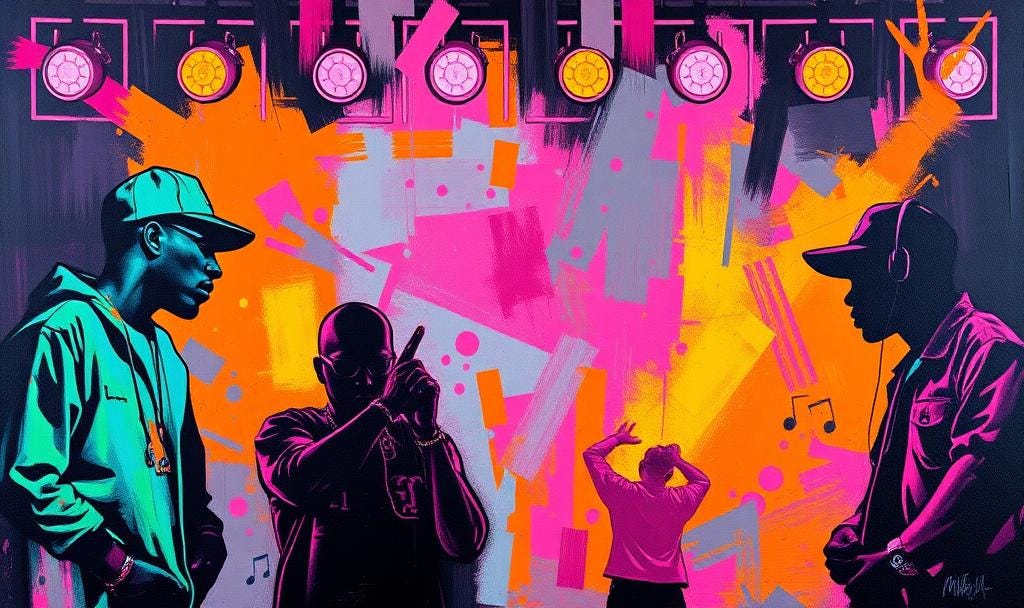Yo! MTV Raps and the Dawn of Hip-Hop’s Golden Age
This is part of my Pop Music in the ‘80s series.
By the end of the 1980s, hip-hop was no longer a fringe movement confined to block parties, dance circles, and independent record shops. It had broken into the mainstream, challenged dominant narratives, and begun to redefine pop culture itself. One of the pivotal catalysts for this shift was a television show that brought hip-hop into living rooms across America: Yo! MTV Raps.
The Debut That Changed Everything
When Yo! MTV Raps premiered in the US in August 1988, it marked a turning point for the genre. Up until then, hip-hop had received little exposure on major music networks like MTV, which largely catered to rock and pop audiences. The arrival of the two-hour Yo! was a statement about the state of popular music in the late ‘80s. Hosted initially by Fab 5 Freddy and later by Ed Lover and Doctor Dre, the show offered a window into a culture that had been building for over a decade, showcasing videos, interviews, and performances from artists across the hip-hop spectrum.
The show’s influence was immediate. It introduced national audiences to a rapidly diversifying range of MCs and styles, from the politically charged rhymes of Public Enemy to the smooth charisma of Big Daddy Kane. It helped solidify the careers of now-legendary artists and gave regional scenes a platform to be seen and heard on a national scale.
From Local to Global
Yo! MTV Raps didn’t both reflected and expanded hip-hop culture. With the rise of cable television, artists who once relied on radio and touring to build audiences could now be seen by millions. For many viewers, the show was their first exposure not just to the fashion, language, and attitude of hip-hop. This was especially true for white kids who often grew up in a time when Black culture was largely marginalized.
This visibility helped launch hip-hop into the so-called “Golden Age of Hip-Hop.” This was a creative explosion roughly spanning the late ‘80s through the early ‘90s. Artists began to experiment with complex lyricism, layered production, and increasingly varied subject matter. The genre matured, and Yo! was there to document that maturation.
Hip-Hop in Dialogue with Television
This is where it gets a little wild. The cultural exchange wasn’t one-way. In fact, American audiences weren’t ready for Yo! MTV Raps when it debuted on MTV Europe in 1987. It was nearly a year before the show came back to the US. As American hip-hop influenced the show on MTV Europe, the show on MTV Europe in return shaped how American hip-hop was presented in America. Did you follow?
By the time the program debuted in the US, hip-hop music videos had become essential to an artist’s image and success, just as they had in rock and pop. Progressively, visuals became more polished and the visual narratives more ambitious. Artists like Queen Latifah, De La Soul, and N.W.A. used the music video format to explore identity, politics, and storytelling in new ways.
The format of Yo! also played a role. Ed Lover and Doctor Dre brought humor, accessibility, and a sense of authenticity to the screen. Their banter, interviews, and off-the-cuff moments helped demystify the genre for unfamiliar audiences without watering it down. This ran contrary to the “anti-rap” narrative that permeated news and other mainstream media. For young fans across the country, Yo! was so much more than a music show, it felt like a cultural lifeline.
Setting the Stage for the ‘90s
By the time the ‘90s arrived, hip-hop had become a permanent fixture in American popular culture, though it still struggled to capture the hearts of mainstream audiences for foreseeable future. Labels invested heavily in rap acts. Films, fashion lines, and even advertising campaigns began to borrow its aesthetics and language. The groundwork laid by Yo! MTV Raps helped usher in this new era.
Yet the success of Yo! also raised questions about how hip-hop would be curated, commercialized, and critiqued. As the genre expanded, so did debates about authenticity, appropriation, and representation.
What Yo! MTV Raps offered was more than exposure; it was validation. It recognized that hip-hop wasn’t a fad. It was a cultural force that would shape so much more than popular music, hip-hop would shape how generations would see themselves and the world around them. In that sense, the show chronicled hip-hop history, while simultaneously shaping the genre’s trajectory.
In spite of all this, no purely hip-hop single would top the US Hot 100 until Vanilla Ice did it with “Ice Ice Baby” on November 3, 1990; just 3 months after Partners in Kryme scored the UK Single’s Chart’s first hip-hop with “Turtle Power!”





